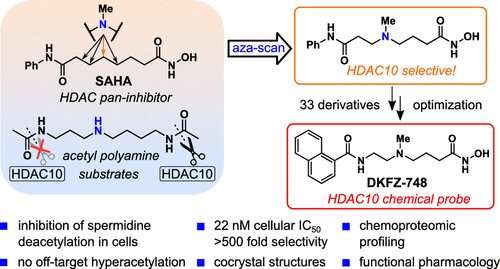A specific inhibitor allows researchers to study an enigmatic enzyme

The enzyme HDAC10 is involved in a variety of cellular processes associated with the development of a number of diseases. However, it is often not known exactly what role HDAC10 plays in the disease process. Scientists from the German Cancer Research Center (DKFZ) have now for the first time synthesized a highly selective inhibitor that can be used to study the function of HDAC10. Their research appears in the Journal of the American Chemical Society.
Histone deacetylases (HDAC) are a family of 18 enzymes that largely interfere with the epigenetics of cells and influence which genes are transcribed. HDAC enzymes play a role in the development of many diseases, including numerous cancers. Five compounds targeting HDAC enzymes are already approved as drugs.
Within the large group of HDAC, HDAC10 is considered a particularly enigmatic representative. Unlike the majority of its family members, this enzyme does not act epigenetically but has been linked to important physiological processes such as autophagy, DNA repair, angiogenesis, and cell proliferation. In addition, studies report that it is involved in inflammatory diseases and transplant rejection.
However, in order to study the exact function of HDAC10, only non-specific inhibitors have been available so far, which also block a number of other HDAC family members. The alternative has been to genetically knock out the enzyme. A team led by Aubry Miller of the German Cancer Research Center has now succeeded for the first time in developing a specific HDAC10 inhibitor.
HDAC10 removes acetyl groups from so-called polyamines, a class of biological compounds that perform a variety of tasks in the cell. The enzyme shows a strong preference for certain representatives of this substance class. Based on this specificity, the DKFZ team succeeded in synthesizing a highly specific HDAC10 inhibitor on the basis of an already known drug that does not selectively block HDAC enzymes.
The compound, called DKFZ-748, is hardly toxic to cells and therefore well suited to study the function of HDAC10 as well as that of its substrates, the polyamines. The research team was able to show that treatment of cells with DKFZ-748 completely suppresses the functions of HDAC10.
Using tumor cells (HeLa), the researchers demonstrated in cell culture that inhibition of HDAC10 by DKFZ-748 curbed cancer cell growth when sufficient polyamines were not available. "This is an indication that HDAC10 normally removes acetyl groups from the polyamines we consume in our diet. Removing the acetyl group makes the polyamines usable by tumor cells, which rely on these compounds for growth," said Raphael Steimbach, lead author of the study, explaining a newly discovered function of HDAC10.
"HDAC10 appears to provide cancer cells with alternative sources of polyamines," says study leader Aubry Miller. "HDAC10 inhibition could therefore potentially support the action of polyamine-blocking cancer therapeutics currently being tested in clinical trials."
More information: Raphael R. Steimbach et al, Aza-SAHA Derivatives Are Selective Histone Deacetylase 10 Chemical Probes That Inhibit Polyamine Deacetylation and Phenocopy HDAC10 Knockout, Journal of the American Chemical Society (2022). DOI: 10.1021/jacs.2c05030
Journal information: Journal of the American Chemical Society
Provided by German Cancer Research Center



















